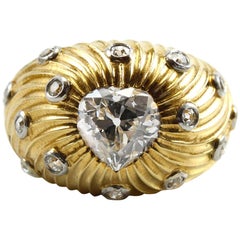Schlumberger Z Ring
Recent Sales
Vintage 1960s American Retro Cocktail Rings
Diamond, 18k Gold
Schlumberger Z Ring For Sale on 1stDibs
How Much is a Schlumberger Z Ring?
Jean Schlumberger for Tiffany & Co. for sale on 1stDibs
Jewelry designer Jean Schlumberger once said that he strived to “make everything look as if it were growing, uneven, at random, organic, in motion.” His jewels interpreted the vitality of the natural world with lively designs that included a moonstone-topped jellyfish brooch with sapphire tentacles exuding a watery shimmer and a ring encrusted with a burst of diamonds that “bloomed” like a flower bud.
A self-taught jeweler, Schlumberger’s mastery of color as well as his expertise as a draftsman brought his fantastic ideas to life. Born to a leading textile manufacturing family in Alsace, France, Schlumberger took to drawing as a child and showed promise as an artist, but his parents instead sent him to study banking in Berlin in the 1930s. Uninspired, he departed for Paris and began creating buttons for Italian fashion designer Elsa Schiaparelli, who also commissioned him for costume jewelry.
One of Schlumberger’s early pieces — a cigarette lighter in the form of a fish whose head opened to reveal the flame — demonstrated his skill for capturing the vivacity of nature in precious metal. The designer’s imaginative jewelry was in contrast to popular geometric lines of Art Deco, an independent vision he affirmed in the extravagant 1941 Trophée de Vaillance brooch created for fashion editor Diana Vreeland. An extravagant confection of diamonds, amethyst, rubies and gold, the brooch featured gemstones adorning an intricate intersection of tiny spears and a breastplate over a glittering shield.
After serving in the French army and the Free French forces during World War II — and surviving the Battle of Dunkirk — Schlumberger left war-torn Europe for New York and in 1946 established a jewelry salon with Nicolas Bongard. There, his vibrant work caught the eye of Tiffany & Co. After joining the American luxury jewelry house in 1956, he soon had his own studio on the mezzanine of Tiffany’s Fifth Avenue store that he accessed by a private elevator. In his workshop, Schlumberger used a rainbow of gemstones, gold and diamonds to create some of the company’s most beguiling designs.
From striking earrings shaped like soaring wings to diamond birds perched on glittering gemstones, each of Schlumberger’s Tiffany designs dazzled. His supporters included Bunny Mellon, whose love for horticulture inspired commissions such as the Jasmine necklace with diamond blossoms flowering from a garland of colored sapphires, and Jacqueline Kennedy, who wore his Croisillon bracelets so often they became known as “Jackie bracelets.” Schlumberger retired from Tiffany in the late 1970s, but decades after his designs were introduced many of his popular pieces remain in production.
On 1stDibs, find an extraordinary range of vintage Jean Schlumberger jewelry designed for Tiffany & Co.
Finding the Right cocktail-rings for You
A flashy symbol of wealth during the early 20th century, antique and vintage cocktail rings have gained broader appeal in the decades since for the hefty dose of glamour they bring to any ensemble.
Cocktail rings earned their name for their frequent appearances during glitzy cocktail parties at the height of the Prohibition era. Back then, these accessories were seen not only as statement pieces but as statements in and of themselves. They openly represented a sense of freedom and independence as well as a demonstration of opulence. After all, the 1920s heralded the Harlem Renaissance and Art Deco design, and a slew of social and cultural shifts meant that women in particular were breaking from pre–World War I conventions and embracing newfound freedoms to express themselves as individuals.
Women expressly wore cocktail rings on the fingers of their right hand versus the left, which was “reserved” for an engagement ring or wedding band, accessories definitely paid for by a suitor. And for cocktail rings, the bigger the colored gem at the center — which is usually mounted in a high setting — and the more elaborate the design, the stronger the likelihood of being noticed.
Cocktail rings remained a popular piece of jewelry for women until the 1930s, when the Great Depression and the onset of war marked a change in behaviors nationwide. While the 1960s and ’70s saw a return in visibility for the accessory, it wasn’t until the 1980s that cocktail rings once again assumed their position as a beacon of luxury and glitz.
During the 20th century, the range of dazzling cocktail rings seems to have been limitless, from glimmering gold rings set with carved jade diamonds designed by David Webb to Pomellato’s pink quartz confections to striking Gucci butterfly rings with accent diamonds set in a pavé fashion.
So, how do you wear a cocktail ring? Cocktail rings “can be worn for almost anything — dinners, date nights, parties, special events, on the red carpet,” explains David Joseph of New York-based jewelry brand Bochic.
Can you wear cocktail rings with other rings? “In my opinion, cocktail rings should stand on their own since they showcase a large gem in the center,” says Joseph.
These glamorous jewels can be worn inside or outside crowded taverns, in either daytime or nighttime with casual or dressy attire. On 1stDibs, find a wide variety of antique and vintage cocktail rings, including those offered by Chanel, whose elegant cocktail rings often feature pearls and, of course, diamonds, and sometimes were styled after showy flowers like the camellia, and Van Cleef & Arpels, whose detailed and intricate designs are viewed as miniature pieces of wearable art.
